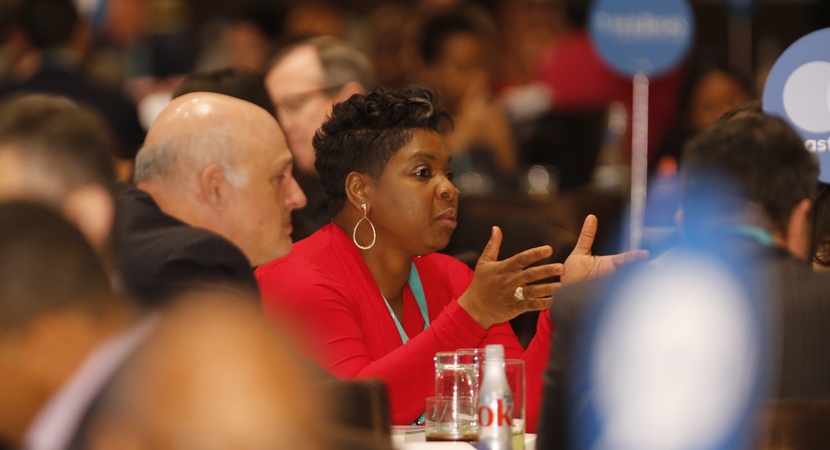
LCLD Members shared ideas on creating more opportunities for diverse talent during table exercises at the 2017 Annual Meeting. (Photo by Joe Mahoney)
A dynamic series of table exercises at the LCLD Annual Meeting in Washington resulted in at least five subjects that LCLD Members selected as fertile ground for further exploration—and experimentation.
The goal of the exercise was to identify areas where legal organizations could challenge old patterns and create new processes for the advancement of diverse talent. These discussions followed a two-day workshop conducted at the June 2017 LCLD Leadership Summit at Harvard, and represent early steps in a strategic expansion for LCLD, adding tools for organizational development to the menu of support offered by LCLD for its Members.
The 25 corporate-hosted tables generated and recorded at least 150 insights and recommendations. Those many observations fell into five general categories for further development:
ASSIGNMENT: When the work comes in, who gets it? Where are the places where unconscious bias creeps in? Where and when can a client give meaningful input? What processes are in place before the work comes in? Can the Rooney and Mansfield rules be harnessed for assignments as well as for hiring and promotions?
SPONSORSHIP: Mentoring is a good start, but sponsorship is a sustained commitment to another’s professional future. It’s also a gamble that the potential of the younger attorney is worth spending down the capital of the senior. Are sponsorships working? The UPS discussion table suggested that “secondments are sponsoring opportunities.” The Federal Home Loan Bank table boldly stated that in-house/firm partnerships should target “...specifically identified diverse associates...” taking sponsorship and secondment to a new level. Worthy areas for experiments.
EVALUATION: Can evaluation ever be free of prejudice? Certainly, it can be better. It should be real-time, with relentlessly objective standards, and third-party involvement from both firm and in-house advisors who can assist the evaluator. An evaluation should be more than “thumbs up/thumbs down.” It should include a path forward, a career plan, with the reviewer committed to checking in at key milestones. This is another rich area for experimentation.
“LCLD is at an historic juncture,” said LCLD President Robert Grey. ”We have an opportunity not only to continue to develop diverse talent that is the best of the best, but to ensure that when these individuals return to their organizations, obstacles to their advancement have been removed and the playing field is level for all.”
ACCOUNTABILITY: The always quotable student of business culture, Sallie Krawcheck, once said, “Middle management is where diversity goes to die.” So how can the “frozen middle” be held accountable to the institution’s larger diversity vision? Corporate legal departments are getting tougher on the subject of accountability. The United Airlines discussion table was resoundingly clear: “For firms that don’t show improvement, there should be consequences.”
METRICS: All of the collaborative experiments to be developed must be undergirded by clearly defined metrics. What are the dollars earned and hours worked by women and minorities? The LCLD “Data Collaborative” project answered those questions for five corporations in a 2017 pilot. Further questions need to be asked. Example: “How does my law firm stack up against my competitive set when it comes to diversity, in comparable, apples-to-apples practice areas?”
At this early point, the scope and shape of experiments to be undertaken by LCLD Members is still being hammered out. Next step: Discussions with corporations and firms who volunteer to run experiments in the categories identified at Annual Meeting roundtables. Stay tuned for more information on how your organization can participate.
If you're interested in working with LCLD to develop an experiment at your firm or company, please contact Erin Hess, LCLD program manager.


